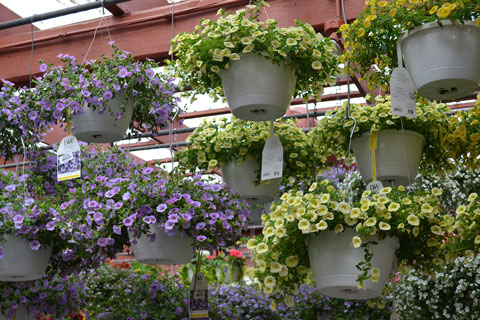7/1/2022
Geting the Right Price
Jennifer Polanz

If you sold garden products this year, chances are you had to increase your prices. If you grew your own live goods, your input costs—from media to plastic pots and tags to fertilizer, heating/cooling costs and labor—all went up. If you bought in plant material, the price was higher because your grower saw increases in all those areas just mentioned, plus you experienced increases in your overhead costs. On hardgoods, freight prompted increases, as did scarcity of raw materials.
Pictured: Talking about the benefits of plants is one way to reduce the focus on price and highlight value.
In an informal survey of retailers and grower-retailers we conducted, the vast majority who answered raised prices on at least some of their live goods, and those increases ranged from 10% to 20%. But when I talked to long-time garden center consultant Sid Raisch, owner of Horticultural Advantage, the price increases some implemented may not have been enough, depending on where they are in the country. He’s basing his thoughts on the weekly reporting through The Garden Center Group, of which he’s a service provider. The average transaction had increased nearly 7% when we talked in late May, but costs have increased by more than that, he says.
“Some are behind because they didn’t raise prices very much and some are considerably ahead because they were aggressive,” he adds.
“(We) increased approximately 10% on average to cover increased supply costs,” writes one Midwest grower-retailer who answered our anonymous survey. “I wish I had increased 12% to 15% because I haven’t had any price complaints, so I think I could’ve gone a bit higher. But that also leaves room to raise more next year.”
Analyzing Pricing
In the Detroit metro area of Michigan, spring came later (like many other parts of the country). I talked to Rick Vespa, VP of Hard Goods Merchandising and President of Landscaping at English Gardens, which has six permanent locations there, about his company’s strategy related to pricing this year.
“Specifically covering operating costs is always the goal,” he says. “Typically, we use historic information to do that. In other words, with fuel costs going up, do we go in and adjust retail prices? No, it doesn’t happen that fast. However, if the fuel cost is part of freight, the way we structure pricing would get into that.”
They look at the landed cost of product—including any surcharges, freight, cross-docking and distribution charges—and use a formula for a markup focused on two points: Initial Gross Margin Objective (IGMO) and Maintained Gross Margin Objective (MGMO).
MGMO is because they know not everything will sell at its initial retail price, so that takes into account discounts to get the overall gross margin they want. That can range anywhere from 40% on food products that have a tighter margin to upwards of 70% on specialty products that aren’t highly
competitive or visible, he says.
That’s where the value comes into play—it’s not an across-the-board markup, but done based on multiple factors.
 Rick also noted that they’ve been less aggressive with discounts and promotions the last three years because high demand has been there, along with reduced supply. Now they’re seeing those two lines on the line chart converging and possibly intersecting, meaning the strategy might have to change some. That’s been in discussion, but Rick still says the year so far has proven to be a good one despite the late start due to the weather.
Rick also noted that they’ve been less aggressive with discounts and promotions the last three years because high demand has been there, along with reduced supply. Now they’re seeing those two lines on the line chart converging and possibly intersecting, meaning the strategy might have to change some. That’s been in discussion, but Rick still says the year so far has proven to be a good one despite the late start due to the weather.
“May (compared) to 2021 is a darned good number—we know most of where we’re at right now is weather-related,” he says. “We can’t tie it to weakening demand, economy, competitive inventory, that kind of thing. We’re not hearing or seeing that yet.
“Right now our strategy is to proceed cautiously.”
Dr. Bridget Behe, a researcher at Michigan State University who’s done multiple studies with eye-tracker software to better understand consumer shoppers, says pricing should remain a smaller piece of the bigger puzzle, and notes retailers should be experimenting with price more and not just raising prices one percentage across the board. However, she does realize that’s a lot more effort.
“If you have a decent POS system, do a little experimentation,” she says. “Not obscenely high, but if you have limited inventory and a brand-new cultivar, bump that price up a little bit. If you watch it and you’re not getting the sell-through, you don’t have to put it on sale, just lower the price.”
Sid adds one of the keys to successful price increases is to offer products that can’t be price matched exactly (mixed containers, baskets that are unique in some way) and to look closer at the equation. Instead of 4 for $25, which puts a $25 pricepoint at the forefront (and potentially a stopping point), he suggests offering 4 or more for $5.99, which makes the value ongoing.
Reducing the Role of Price
In Bridget’s eye-tracking studies (one of which you’ll read more about in an upcoming issue of Green Profit), she found out something that sounds shocking, but if we think about it, we probably already knew it: “From the eye-tracking work we know that three to five seconds is our universe of choice.”
That’s right. You don’t have minutes to catch attention, you have three to five seconds. In that short amount of time, do you want them focusing on price?
“The problem is we make price this big headline and it really needs to be this smaller byline,” Bridget adds. “Because if I can look 20 feet away and see something that is—I’ll just pick a number—$19.99, and that’s all I see? That makes it really easy for me to dismiss.”
I’ve seen a lot more people messaging to the benefits of plants, but we can always improve, and Bridget says that’s the key to converting the sale: messaging the benefits. If you can tell customers plants were grown using safer pest management chemistry or strategies—or better yet, if they were grown locally and have a reduced carbon footprint—now you have talking points that supersede price. That messaging can begin before they enter the store, too, on the website and in social media posts.
She adds Dr. Charlie Hall and Dr. Melinda Knuth have conducted multiple research studies into the benefits of plants, and a link to those (the link also includes marketing material that can be used freely by industry members) can be found in the sidebar “More Resources.”
Rick notes that their No. 1 live goods seller is hanging baskets and they promote them to be used in three ways: hang them, plant them in the ground for bigger material fast or drop them in your favorite container. Talk about adding value and versatility: that’s three options with one purchase.
Adding Value Outside of the Product
There are other ways to show value that have nothing to do with the product itself. Store environment is one of them, Sid says.
New paint and signage helps to look refreshed and ready for customers, too. It seems like a small thing, but it goes a long way to getting that perceived value.
 Rick has a great list of ways anyone can build perceived value, too. First and foremost, the stock has to be there. That does require assuming some risk, he says, but that’s the “wow” factor that creates
Rick has a great list of ways anyone can build perceived value, too. First and foremost, the stock has to be there. That does require assuming some risk, he says, but that’s the “wow” factor that creates
excitement.
Pictured: English Gardens in the Detroit metro area highlights three ways customers can use hanging baskets: by hanging them, planting them in the ground or dropping them in their favorite container.
Next on his list is offering a wide assortment for customers to get the whole job done in one go: that’s the plants, soil, fertilizer, shovel, pots, controls and anything else they need for their project (we’ll talk projects more in a minute).
His next note was an eye-opener: bring your customers the new and improved—pre-shop for them to give them what you know to be the “right stuff,” whatever it may be. More signage (directional, product info and category info) all helps to answer questions, and well-merchandised displays let customers visualize how items go together (and provides tie-in sales that customers might not have otherwise realized).
His last one: service. People to answer questions, carry out and load cars, check out efficiently and provide a great experience.
Summer/Fall and Beyond
Rick doesn’t have a crystal ball, unfortunately, but aggressive supply chain management and strong vendor relationships got them to this point, and those will continue to move the needle for English Gardens. They anticipated the supply chain constriction and ordered product that can be stored to be ready for 2023. He feels supply chain issues, variable freight costs and delays in product availability all will continue next year, but after that it might change.
Sid, meanwhile, is focusing on finishing out 2022 strong by counseling retailers who had a sluggish start to focus on project-oriented customers and those who may balk at vacations at $5 a gallon for gas.
“What you can do is make up that difference with the customers you have, if you’re paying attention every day, all day long every day of the year,” he says. “Vigilance is there. It takes an effort to engage every customer to get that.”
He encourages asking each customer not just about sun/shade and soil conditions, but “why are they there?” Are they working on a project? What’s the project scope? How can you help achieve the project objectives?
“People have been on the move for two years and are still moving. Retirees are moving, young people are moving. We have a very mobile society in broad ages and so they have projects to do,” he adds. “That’s really the key to a bigger average transaction. If you engage every customer who comes through every day, find the projects and help them with that.”
More Resources
Dr. Bridget Behe at Michigan State University has multiple studies using eye-tracking technology to better understand consumer shopping habits. You can find those studies, as well as her podcast, at www.connect2consumer.com.
Dr. Charlie Hall (Texas A&M) and Dr. Melinda Knuth (now at NC State) have multiple research papers available on the benefits of plants, as well as marketing material designed for hort industry use. Visit ellisonchair.tamu.edu/benefitsofplants for those resources. GP